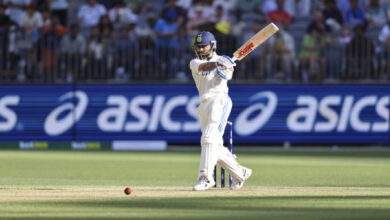T20 World Cup: Poor pitches, due to bad planning and organisation, may end up further alienating USA from cricket | Cricket News

Unusual protagons have entered a T20 narrative; pitch, uneven bounce, seam, swing, fast bowlers, rib cage. It is as though India and Pakan are resuming their Test ties in New York this Sunday, when they meet in the showpiece game of the World Cup. Only that the arch rivals are locked in peculiar circumstances, something the T20 world has seldom come across.At the heart of the intrigue are the drop-in pitches that have been far from ideal for a T20 game or a tournament that is seen as cricket’s grand pitch to enter the US market. Largely untested because of the delay in laying them – thanks to the organisational ineptitude of the ICC and USA cricket board – they have been dangerously unpredictable so far. In the India vs Ireland game on Wednesday, at the same venue, India skipper Rohit Sharma and Rishabh Pant suffered blows on the body because of balls taking off from a good length. Earlier in the same game, a delivery from new-ball bowler Arshdeep Singh had skidded all along the surface.
After the win over Ireland, Rohit wasn’t sure about the kind of pitch they would get for the Pakan game. “It’s a new ground, a new venue, with a drop-in pitch. We weren’t really aware of what it would be like to play on a pitch that’s just five months old. It was all about getting used to the conditions… I don’t think the wicket settled down even when we batted second.”
Others have been more brutal in their assessment of the track. Calling the surface substandard, former England captain Michael Vaughan wrote on X: “Trying to sell the game in the states is great… love it… but for players to have to play on this sub-standard surface in New York is unacceptable…You work so hard to make it to the WC then have to play on this.”
Wasim Jaffer was sarcastic: “This is an excellent pitch, provided the idea was selling Test cricket to the Americans.”
On a Cricbuzz show, Virender Sehwag questioned the logic of promising entertaining cricket but producing boring wickets. “If you want to take cricket to America, you should do it in such a way that the Americans who come to watch the game are entertained. If these are wickets brought from Adelaide, they should behave like one from Adelaide, where 300 runs are scored in ODIs. This is not the case here,” he said.
Meanwhile, the ICC in a statement acknowledged that the “pitches have not played as consently as we would have all wanted” and they were working to find a solution. “The world-class grounds team has been working hard since the conclusion of yesterday’s game to remedy the situation and deliver the best possible surfaces for the remaining matches”.
The fiasco was foreseeable. Once USA Cricket got the right to co-host the T20 World Cup, they decided to turn part of a sprawling park, Van Cortlandt Park, in the heart of Bronx, into a cricketing stadium. It proved to be a futile idea as the locals didn’t want cricket encroaching on their park. The issue became a talking point with a state representative opposing it in the Senate, saying: “No. N-O. In caps, underlined, boldfaced, italicised. No.”
Michael Vaughan and Virender Sehwag have been critical in their assessment of the pitch on offer in New York. (AP/PTI)
the time an alternative was sketched towards the end of last year, the Eisenhower Park, winter had set in. It was only in March that work began on the parkland where the stadium has sprung up. The ICC has produced a time-lapse video on its supersonic transformation from a snow-draped parkland to a grass-covered cricket field with modular stands. But if only preparing an outfield and pitch were as simple as that.
Not for lack of effort
The best men in the pitch-making business were hired. Damien Hough has sparkling credentials as the chief curator of the Adelaide Oval, one of the finest grounds in the world. The ICC also hired LandTek, a local company specialising in sports facilities. Together, they conceptualised a mini-miracle in five months.
A large and elegant structure sprung up, surprising local residents. But the pitch, though, was a different beast. It had to travel 22,000 kilometres, from Adelaide, via different time zones, through the port of Savannah, Georgia to Boynton Beach in Florida, where the grass was sown and allowed to flourish under the sparking Florida sun. Finally, at the end of April, it reached New York. “Since then, we’ve just allowed it to grow in, given it time to adjust to the natural conditions it’s facing,” Hough told The Guardian.
He and his colleagues had picked the best lot of pitches — four for games and six for warm-ups — but he admitted that there is always an element of risk on how a particular variety of grass adjusts to a vastly different environment. “You know you’ve thought through the processes, you know you’re happy with the way it’s come together… but at the same time, until you have those games, you’re not sure, because the pitch is only five months old. It’s a short period of time to build a cricket pitch and play on it,” he would say.
There were challenges that Hough encountered on the go, like a bitter winter, the lack of consent sunshine, the high clay content of the outfield, an unfamiliar soil type, used for baseball mounds, an unknown variety of Bermuda grass called Tahoma 31 for the pitches, and Kentucky Bluegrass for the outfield. Even the depth of the grass was deeper than it was in Australia, which combined with the clayey soil could account for the sluggish outfield.
Most importantly, the surfaces didn’t have time to bed in. No cricket was played on them until the warm-ups. In a sense, it was like an organ transplant gone horribly awry, not because of a lack of expertise but due to haste and clumsy planning. There is hope that the surface would become better with time— Hough likens it to a human being, needing time to adjust and recover. Drop-in surfaces do improve with time, but in Australia and New Zealand. In the US, there is little hory to lean on for proof. There is only uncertainty.
Thus, the tournament that was supposed to bring America closer to cricket could produce the opposite effect. It has been an event marred organisational dysfunction, the startling incompetence in handling a big tournament, which the ICC too can’t wash its hands off. Cricket’s endeavour to break new ground could easily end up breaking the ground beneath the sport in the country, if planning and organisation does not match the ambition.







